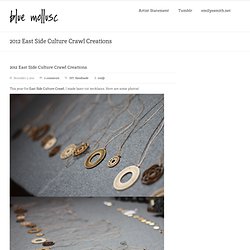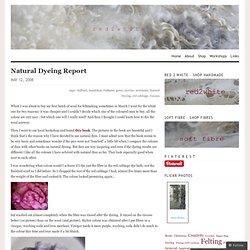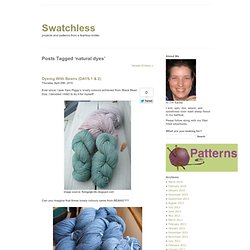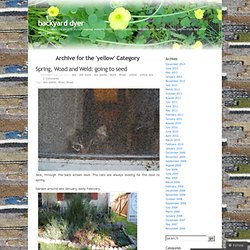

Handmade « bluemollusc.com. Recently Finished: Norwegian House Slippers I’ve been spinning fairly dense these days so this project was a great way to use up some of that wool, and make long-lasting slippers!

(Plus it was super easy). Here is a link to my Ravelry project page for the pattern and more info. Echoes of a Dream: Natural dyeing. A beginners guide.............. Gulp....A number of people have asked me questions about this dyeing lark and I thought maybe I ought to do a post (another one I hear you mutter) in a tutorial sort of way.

I hesitate because I'm no expert but just a mad woman who got hooked over the summer. So what I would like to do is share some of the knowldge I've accumulated, the suppliers I've used (sorry no web link to Mother Nature yet) and to tell you about the colours I got. First off, a WARNING. Natural dyeing is highly addictive. You will never look at a plant in the same way again and your friends and neighbours will start locking their garden gates. The Raw Materials. Mordants - Surfactant - Soda and more. A Gift from the Herbs: Plant Dyes. It’s a gray day in July.

It's supposed to be summer. Outside the skies are clotted with thick gray clouds, weeping a warm rain now and again. It’s pretty gloomy, especially since this summer has been like that: lots of gray, not much color. But in my friend Rain’s house, there is a riot of color: on her stove, simmering away, we have pots of color. St. Green. Among the four of us, we represent about 70 years of herbal experience, from a wide range of backgrounds. Ho puts as much emphasis on the use of Chinese herbs for healing, as she does the needles. With all these years of experience we have with plants, it’s pretty surprising that none of us have ever worked with plant dyes. In reading about these aniline dyes, I was horrified to learn that the dust they create is in fact toxic to the workers who handle them. ’s wort flowers from an open field near our house. So what is happening here?
Natural Dye Mordant; Fiber and Yarn Preparation for Natural Dye. These natural dye mordant and wash instructions are focused on wools and silk since they dye the best with natural dyes.

If dyeing cellulose fibers, please pay close attention to additional notes. For more information on natural dye mordants please see this mordant page Important note: Weigh the amount of yarn or fiber you plan to dye before making it wet. Amount of mordant and dyestuff to use is based on a percentage of the dry weight of your material. Washing Wash your fibers/yarns even if they look really clean. Natural Dyeing Report « Red 2 White. When I was about to buy my first batch of wool for feltmaking sometimes in March I went for the white one for two reasons: it was cheaper and I couldn’t decide which one of the coloured ones to buy, all the colour are very nice - but which one will I really need?

And then I thought I could learn how to dye the wool anyway. Then I went to our local bookshop and found this book. The pictures in the book are beautiful and I think that’s the reason why I have decided to use natural dyes. I must admit now that the book seems to be very basic and sometimes wonder if the pics were not “touched” a little bit when I compare the colours of dyes with other books on natural dyeing. But they are very inspiring and even if the dyeing results are different I like all the colours I have achived with natural dyes so far. List.emich.edu/~dyers/pdfs/dyeglossary.PDF. Natural dyes. The Flame is in Canada As the Olympic torch gets handed to Canada today, it is making me look ahead to the upcoming Olympic games.

I’m getting antsy, trying to choose an epic project for the Knitting Olympics. I missed the boat in 2006, but have been in training since then. I have already competed for Team Canada in the Ravelympics (for summer sports) in the events of “Fleece-to-Finished Fencing”, “Handspun Heptathalon”, “Mitten Medley” and “Hat Dash”. Apartment Therapy Re-Nest. Previous image Next image Choose the color.

I found a page from an old book all about creating vegetable dyes! The author and source are unknown, but the dyes are absolutely gorgeous! Yellow « backyard dyer. Hibiscus Rose Mallow (Hibiscus spp.) on Wool, scoured but no pre-mordant or pre-Alum.

Far left, Hibiscus with a pinch of copper after-bath. Middle, dried Hibiscus flowers mashed (in the dye pot while simmering, before adding the wool) to yield a darker color. On the right wool and soy-silk simmered conventionally with dried Hibiscus. Other fibers – like silk – will probably get different results – but this is what I got dying wool. Again, the wool samples were not pre-mordanted. One well might ask why more yellow. Next, I’m trying to find local plants that don’t require strong chemical mordants. Copper after-bath on the far left could have been accomplished with an Indigo over-dye, otherwise the rest of the tests were done without mordanting (copper, tin, chrome, etc.) Lastly, Hibiscus is easily available in Los Angeles, southern California, and works dried or fresh. Dyeing « Frog in the pond. Colours from our backyard September 22, 2010 at 11:55 am (Dyeing, textiles) These are the results of my eucalyptus and brown onion skin dyeing.

Dye - Dyes From Plants - Pioneer Thinking. Did you know that a great source for natural dyes can be found right in your own back yard!

Roots, nuts and flowers are just a few common natural ways to get many colors. Yellow, orange, blue, red, green, brown and grey are available. Go ahead, experiment! Gathering plant material for dyeing: Blossoms should be in full bloom, berries ripe and nuts mature. Remember, never gather more than 2/3 of a stand of anything in the wild when gathering plant stuff for dying.
Journal of the Chemical Society - Chemical Society (Great Britain), Royal Society of Chemistry (Great Britain)